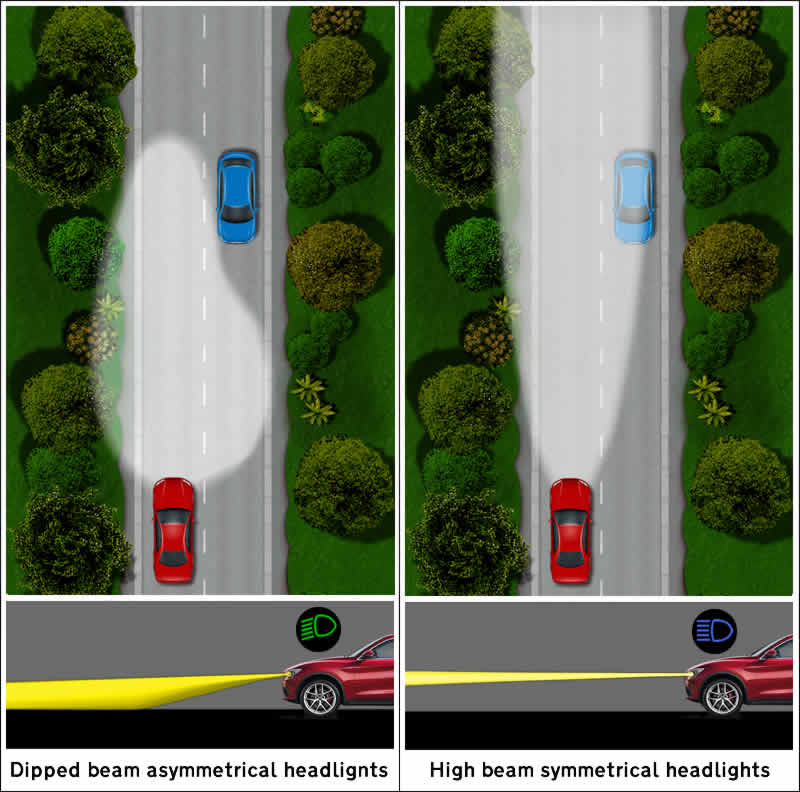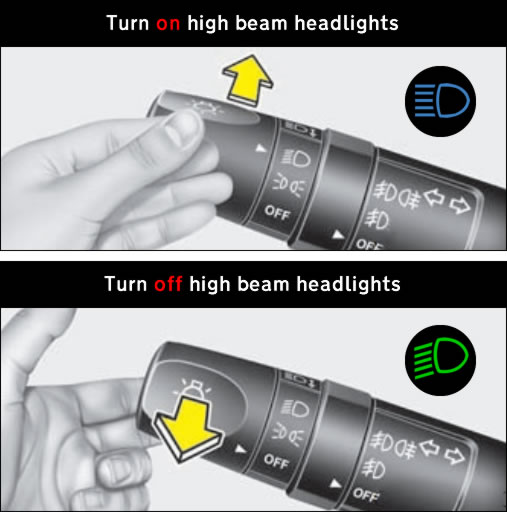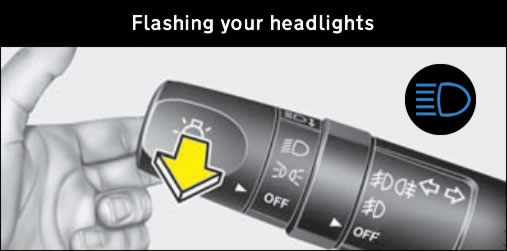High beam headlights are also referred to as ‘main beam’ or ‘full beam headlights’. High beam headlights emit a symmetrical and conical beam pattern aimed straight ahead and parallel with the road surface, providing maximum long distance visibility in darkness.
In contrast, dipped beam headlights are your normal night-driving lights and emit an asymmetrical beam aimed lower towards the road surface so to prevent dazzling the eyes of other road users. Dipped beam headlights are not as powerful and bright as high beam headlights.

To prevent headlight glare, we can see in the diagram that the asymmetrical dipped beam headlights provide less illumination for the lane with oncoming traffic. But for your own lane, the left-side headlight beam is aimed slightly higher allowing for better long distance visibility.
Low beam headlights also illuminate a wider angle at close range than high beams, allowing for greater peripheral visibility – particularly useful for observing pedestrians and cyclists at the side of the road in towns and cities.
However, the more powerful symmetrical high beams emit a long distance conical beam, illuminating both sides of the road equally. But due to the objective of high beams being distance, they typically offer less peripheral visibility, particularly at closer range.
When Can You Use High Beam Headlights?
You can use your high beam headlights when it’s dark and you’re in a poorly lit area. A good example is to use high beam headlights on country roads. The high beams will illuminate sharp corners and obstacles in the road well in advance.
They may also help to warn you in advance of any animals at the side of the road that may cross your path. However, be cautious when approaching left hand bends as your high beams can easily blind another driver’s eyes.
You can also use high beams on main roads that are unlit, but always be sure to switch off the high beams if there are other vehicle coming towards you, or if you begin following another vehicle.
When Should You Not Use High Beam Headlights?
You should never turn on your high beam headlights if you are:
- Meeting Oncoming Traffic
Meeting oncoming traffic also includes vehicles, cyclists and pedestrians. Switch your headlights from ‘high’ to ‘dipped’ in good time to avoid dazzling them. - Following Vehicles
When following another vehicle, your high beam headlights will dazzle the driver’s eye in their mirrors. If overtaking, only switch to high beams once you are alongside the other vehicle. - Entering a Left Hand Bend
When driving around a left hand bend, it’s difficult to see an approaching vehicle. With full beams on, your lights will glare directly into the driver’s eyes. It’s usually a good idea to switch to dipped beam just before entering a left hand bend. - Driving in Fog or Rain
It’s also a good idea to avoid using high beams in fog and rain as the powerful lights reflect from the water particles in the air. This light reflection can reduce your view of the road ahead. Instead, use dipped beam headlights that shine lower towards the road surface, or use fog lights only in foggy conditions where you’re unable to see further than 100 metres. - Driving in Towns or Cities
While driving at reduced speed limits in towns and cities, dipped beams are usually bright enough, particularly when there are street lights. The wider angle of dipped beams is suited to urban driving as these lights will help to illuminate areas of your peripheral vision.
How to Switch High Beam Headlights On and Off
For your car’s high beams to operate, either the ignition will need to be on, or the engine started. First switch on your headlights.
The headlights are your normal night driving lights, which are the same as dipped, or low beam. You’ll know when your headlights are on because you’ll see the green headlights symbol ![]() on your dashboard instrument display.
on your dashboard instrument display.
On most cars, you operate the high beam lights function by using the left-side lever on your steering wheel. To turn on your high beam headlights, push the lever away from you. You’ll know when high beam headlights are on because you see the blue symbol ![]() light up in your dashboard instrument display.
light up in your dashboard instrument display.

To turn off the high beams and go back to dipped beam, you simply reverse the action and pull the left-side lever back towards you. The blue high beams symbol ![]() will then switch off.
will then switch off.
Flashing Your Headlights
Flashing your headlights is where you briefly switch on the high beam headlights as a means to communicate with another road user. To flash your headlights, simply pull the left-side lever towards you for the duration that you want the headlights to illuminate, then release. The lever will automatically return to its previous position when you release it.
The high beam headlights will illuminate regardless of whether other external lights are switched on or off. When you flash your headlights, you’ll briefly see the high beams symbol ![]() illuminate on your dashboard instrument cluster, then go off when you release the lever.
illuminate on your dashboard instrument cluster, then go off when you release the lever.

As stated within rule 110 of the Highway Code, you should only flash your headlights to let other road users that you’re there. However, many drivers flash their headlights for other reasons such as telling another driver that they can pull out in front of them, or to tell a pedestrian that they can cross the road for example.
Whilst this friendly gesture technically isn’t illegal, there are potential dangers associated with flashing your headlights in this manner. In this situation, drivers and pedestrians may act impulsively and act without making the necessary safety observations.
The safest method in this situation is to calmly wait for that person to make their own judgement and to move on when they feel safe to do so. However, if you really feel that you must flash another road user to allow them to cross your path, only do so when you are sure that it’s safe for them to proceed. If it isn’t or if you’re not sure, do not flash your headlights.
Automatic High Beams
Automatic high beams, or ‘high beam assist’ is technology that’s becoming more common in modern cars. High beam assist uses a camera sensor often located at the top centre of the windscreen, which recognises a vehicle’s headlights or tail lights and automatically switches from high to dipped beam.
Once the technology determines that no other vehicles are in front, the system will switch from dipped beams to high beams.